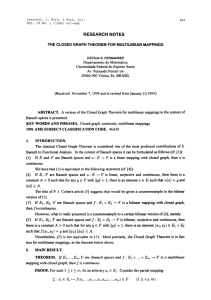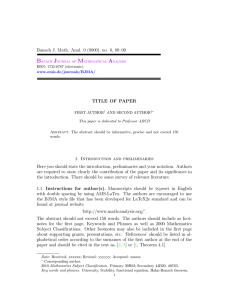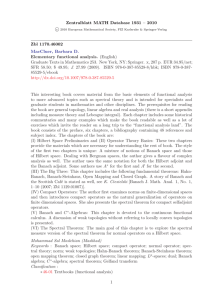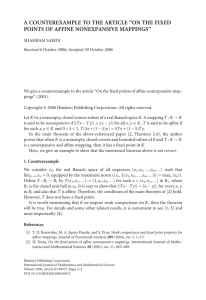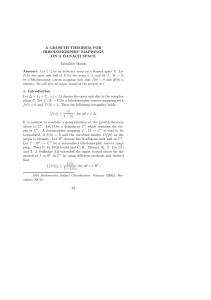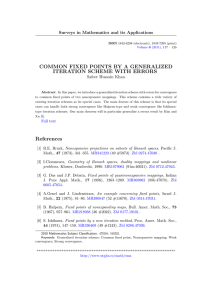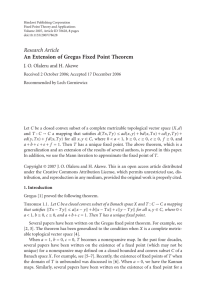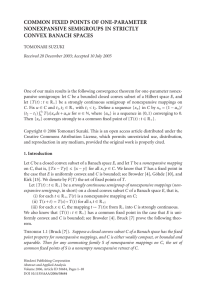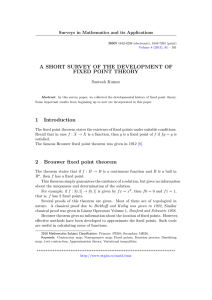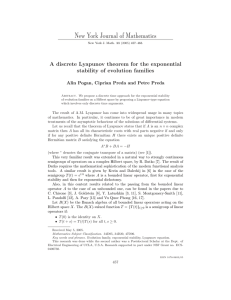MORSE-SARD THEOREM FOR DELTA-CONVEX CURVES
advertisement
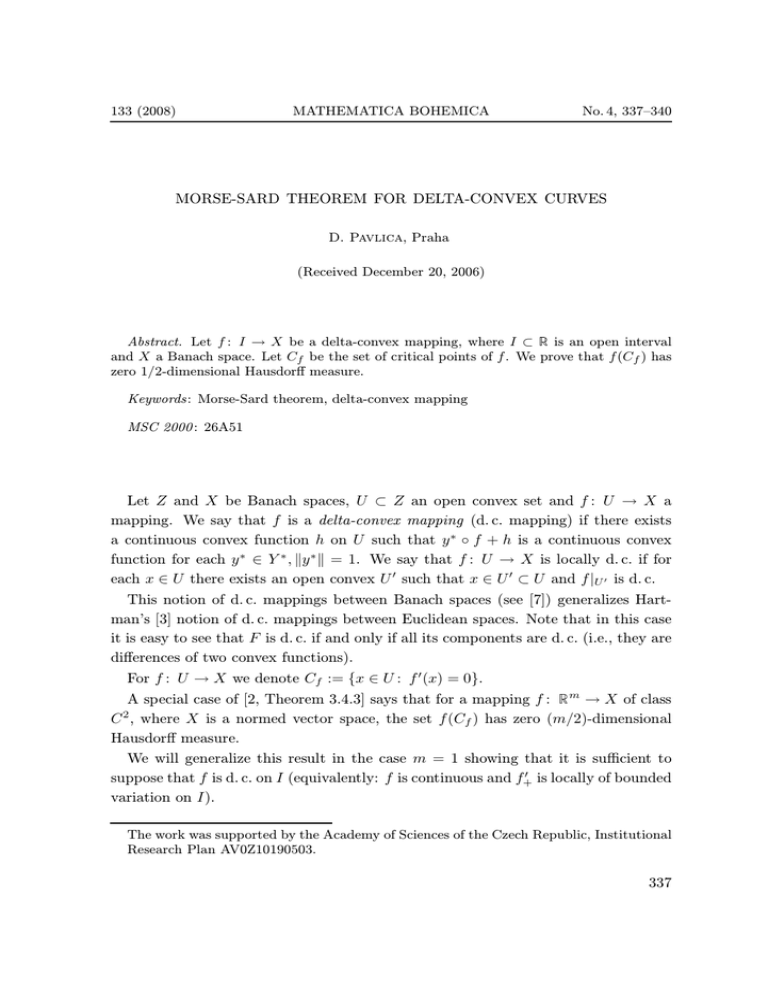
133 (2008)
MATHEMATICA BOHEMICA
No. 4, 337–340
MORSE-SARD THEOREM FOR DELTA-CONVEX CURVES
D. Pavlica, Praha
(Received December 20, 2006)
Abstract. Let f : I → X be a delta-convex mapping, where I ⊂ R is an open interval
and X a Banach space. Let Cf be the set of critical points of f . We prove that f (Cf ) has
zero 1/2-dimensional Hausdorff measure.
Keywords: Morse-Sard theorem, delta-convex mapping
MSC 2000 : 26A51
Let Z and X be Banach spaces, U ⊂ Z an open convex set and f : U → X a
mapping. We say that f is a delta-convex mapping (d. c. mapping) if there exists
a continuous convex function h on U such that y ∗ ◦ f + h is a continuous convex
function for each y ∗ ∈ Y ∗ , ky ∗ k = 1. We say that f : U → X is locally d. c. if for
each x ∈ U there exists an open convex U ′ such that x ∈ U ′ ⊂ U and f |U ′ is d. c.
This notion of d. c. mappings between Banach spaces (see [7]) generalizes Hartman’s [3] notion of d. c. mappings between Euclidean spaces. Note that in this case
it is easy to see that F is d. c. if and only if all its components are d. c. (i.e., they are
differences of two convex functions).
For f : U → X we denote Cf := {x ∈ U : f ′ (x) = 0}.
A special case of [2, Theorem 3.4.3] says that for a mapping f : R m → X of class
C 2 , where X is a normed vector space, the set f (Cf ) has zero (m/2)-dimensional
Hausdorff measure.
We will generalize this result in the case m = 1 showing that it is sufficient to
′
suppose that f is d. c. on I (equivalently: f is continuous and f+
is locally of bounded
variation on I).
The work was supported by the Academy of Sciences of the Czech Republic, Institutional
Research Plan AV0Z10190503.
337
A similar generalization of the above mentioned result on C 2 mappings holds for
m = 2 as is shown (by a completely different method) in [6] where it is proved that
f (Cf ) has zero 1-dimensional Hausdorff measure for any d. c. mapping f : R 2 → X.
Whether f (Cf ) has zero (m/2)-dimensional Hausdorff measure for each d. c. mapping f : R m → X for m > 3 remains open even for X Euclidean space.
We denote α-dimensional Hausdorff measure (on a metric space X) by Hα and
for each Y ⊂ X we put (see [5])
X
∞
∞
[
ωα
α
α
Mi ,
H∞ (Y ) = α · inf
diam (Mi ) : Y ⊂
2
i=1
i=1
where ωα = (Γ(1/2))α · (Γ(α/2 + 1))−1 .
For an open interval I, a Banach space X, g : I → X and x ∈ I, we denote
md(g, x) := lim
r→0
kg(x + r) − g(x)k
.
|r|
If g is Lipschitz, then md(g, x) exists a.e. on I. This fact is a special case of Kirchheim’s theorem [4, Theorem 2] on a.e. metric differentiability of Lipschitz mappings
(from R n to X). In a standard way we obtain the following more general fact.
Lemma 1. Let I be an open interval, X a Banach space, and let g : I → X have
bounded variation on I. Then md(g, x) exists almost everywhere on I.
x
W
P r o o f . We may suppose I = R . Denote s(x) = g, x ∈ R . By [2, 2.5.16.]
0
there exists a Lipschitz mapping H : R → X such that g = H ◦ s. By [4, Theorem 2],
md(H, x) exists a.e. on R . Now, changing in the obvious way the last argument of
[2, 2.9.22.], we obtain our assertion.
Theorem 2. Let X be a Banach space, I ⊂ R an open interval and f : I → X a
locally d. c. mapping. Let C := {x ∈ I : f ′ (x) = 0}. Then H1/2 (f (C)) = 0.
P r o o f.
Note that f is continuous on I (see [7, Proposition 1.10.]). By [7,
′
Theorem 2.3], f+
exists and has locally bounded variation on I. Consider an arbitrary interval [a, b] ⊂ I. It is clearly sufficient to prove H1/2 (f (C1 )) = 0, where
C1 := C ∩ (a, b).
′
Let N1 be the set of all isolated points of C1 and N2 := {x ∈ C1 : md(f+
, x) does
1/2
not exist}. Since N1 is countable, H (f (N1 )) = 0.
To prove H1/2 (f (N2 )) = 0, consider an arbitrary ε > 0. By Lemma 1, we find a
countable disjoint system of open intervals {(ai , bi ) : i ∈ J} such that
[
X
N2 ⊂
(ai , bi ) ⊂ (a, b),
(bi − ai ) < ε and (ai , bi ) ∩ N2 6= ∅, i ∈ J.
i∈J
338
i∈J
′
Clearly kf+
(x)k 6
bi
W
ai
′
f+
for each i ∈ J and x ∈ (ai , bi ). Using the continuity of f
and [1, Chap. I, par. 2, Proposition 3], we obtain
diam(f ((ai , bi ))) 6 (bi − ai ) ·
bi
_
′
f+
.
ai
Therefore, using the Cauchy-Schwartz inequality, we obtain
1/2
bi
_
ω1/2 X
′
f
(b
−
a
)
·
i
i
+
21/2 i∈J
ai
1/2
_
1/2
1/2 X _
bi
b
ω1/2 X
ω1/2
′
′
.
f+
6 1/2
(bi − ai )
6 1/2 ε1/2
f+
2
2
a
i∈J
i∈J a
1/2
H∞
(f (N2 )) 6
i
1/2
Since ε > 0 is arbitrary, we have H∞ (f (N2 )) = 0; consequently (see [5, Lemma 4.6.])
we obtain H1/2 (f (N2 )) = 0.
To complete the proof, it is sufficient to prove H1/2 (f (C2 )) = 0, where C2 =
′
C1 \ (N1 ∪ N2 ). Let ε > 0 be arbitrary. Clearly md(f+
, x) = 0 for each x ∈ C2 .
Therefore, for each x ∈ C2 we can choose δx > 0 such that [x − δx , x + δx ] ⊂ (a, b)
′
and kf+
(y)k 6 ε |y − x| for each y ∈ [x − δx , x + δx ]. Using the continuity of f and
[1, Chap. I, par. 2, Proposition 3], we obtain diam(f ([x − δx , x + δx ])) 6 2ε(δx )2 .
Besicovitch’s Covering Theorem (see [5]) easily implies that we can choose a countable set A ⊂ C2 such that
C2 ⊂
[
x∈A
[x − δx , x + δx ] and
X
x∈A
2δx 6 c(b − a),
where c is an absolute constant (not depending on ε). Since ε > 0 is arbitrary,
f (C2 ) ⊂
[
x∈A
f ([x − δx , x + δx ]),
and
X
x∈A
1/2
(diam(f ([x − δx , x + δx ])))1/2 6
X√
x∈A
we have H∞ (f (C2 )) = 0, hence H1/2 (f (C2 )) = 0.
2ε δx 6
√
2ε c(b − a),
R e m a r k 3. Since each C 2 -function on I is a locally d. c. function (see [7]),
[2, 3.4.4.] implies that the conclusion of Theorem 2 does not hold with Hα (α < 1/2)
in general.
339
References
[1] N. Bourbaki: Éléments de mathématique IX., Les structures fondamentales de l’analyse.
Livre IV: Fonctions d’une variable réelle (théorie élémentaire). Act. Sci. et Ind. vol.
1074, Hermann, Paris, 1968.
[2] H. Federer: Geometric Measure Theory. Die Grundlehren der mathematischen Wissenschaften, Band 153, Springer, New York, 1969.
[3] P. Hartman: On functions representable as a difference of convex functions. Pacific J.
Math. 9 (1959), 707–713.
[4] B. Kirchheim: Rectifiable metric spaces: local structure and regularity of the Hausdorff
measure. Proc. Amer. Math. Soc. 121 (1994), 113–123.
[5] P. Mattila: Geometry of Sets and Measures in Euclidean Spaces. Fractals and Rectifiability. Cambridge Studies in Advanced Mathematics, 44, Cambridge University Press,
Cambridge, 1995.
[6] D. Pavlica, L. Zajíček: Morse-Sard theorem for d. c. functions and mappings on R 2 .
Indiana Univ. Math. J. 55 (2006), 1195–1207.
[7] L. Veselý, L. Zajíček: Delta-convex mappings between Banach spaces and applications.
Dissertationes Math. (Rozprawy Mat.) 289 (1989).
Author’s address: D. Pavlica, Institute of Mathematics, Academy of Sciences of the
Czech Republic, Žitná 25, 115 67 Praha 1, Czech Republic, e-mail: pavlica@math.cas.cz.
340
zbl
zbl
zbl
zbl
zbl
zbl
zbl


